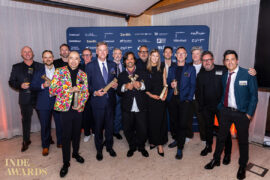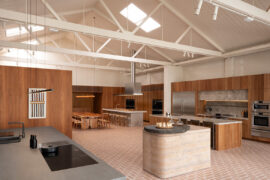Following their recent win at the Good Design Awards (2018) for the EDO Streetscape, we catch up with the NZ powerhouse Schamburg + Alvisse.

Following Schamburg and Alvisse’s recent Gold Award win at the Good Design Awards (2018) for the EDO Streetscape, Schamburg + Alvisse’s latest collection, we caught up with the prolific pair to learn what’s happening in the commercial space – and where to next.

We often hear about changes in the commercial space from the perspective of the owner or end-user – as designers of commercial furniture, what do you view as the biggest changes in the commercial landscape?
S+A: For us, probably the biggest change has to have been the emergence of the agile workplace. More than ever, we’re finding that clients are looking for furniture solutions that support flexibility in all its forms: so multi-purpose furniture, or modular systems that can be rearranged as the team grows and changes. That’s a big challenge that we tend to hear about a lot – people are staying in jobs for a much shorter period than they used to, and they’re moving around a lot within that job. So clients are looking for furniture that accommodates this.
We’ve also noticed that the idea of “wellness” is far more mainstream in the commercial sector now than it was previously, as is sustainability. But overall, the biggest change is probably that idea of agility.
In terms of this change – agility becoming a major priority, and, I suppose, furniture needing to keep up with this – which factor do you think drives the other? Does changing workplace culture inform commercial furniture design, or vice versa?
S+A: It works both ways. Design never exists in a vacuum – it’s always going to be influenced by other things – but it definitely does also shape behaviours. As designers, we need to walk this fine line between responding to existing behaviours and encouraging new, hopefully better ones, and to do this requires a bit of give and take. So, yeah, it definitely goes both ways.
Does technology have a role to play in all this?
S+A: In changing workplace culture? Definitely. The agile workplace is, at least the way we see it, a by-product of a lot of the technology that’s come into offices in the past twenty years. A large part of why people can now work in such a wide range of ways and places comes down to things like mobile devices, the internet…tech has also helped break down a lot of the more traditional barriers of communication and made collaboration a more natural, appealing idea.
Last year marked twenty years of Schamburg + Alvisse, which is an incredible achievement. In the time that you’ve been involved in the industry, how have you seen attitudes evolve in terms of sustainability and environmental issues?
S+A: When we first started in 1997, sustainability was very much still a sort of fringe idea. Not too many people in commercial furniture were interested in pushing the envelope of ‘green design’, and looking toward making products that didn’t cause unnecessary harm to the environment. We had to search long and lard to connect with kindred spirits who cared about sustainable design, eventually connecting with the likes of John Gertsakis, Kirsty Mate, Dr. Cameron Tonkinwise, and a host of idealistic architects and designers all grappling with improving indoor air quality and conserving fast dwindling natural resources.
This has definitely turned around, with the Green Building Council and Good Environmental Choice Australia (GECA) being instrumental in facilitating this change. Designing for compliance with GECA is now seen in architecture and design as simply ‘best practice’. The mainstreaming of sustainability is now such that it has become a sort of marketing buzzword. In that sense, I think you need to approach sustainability with a bit of caution, because some of the genuine engagement with environmental issues is lost a bit in this marketing conversation. But overall, sustainability is definitely more widely embraced now and that can only be a positive thing.
Has Schamburg + Alvisse’s own approach to sustainability changed at all over this same period?
S+A: We’re more committed than ever to making our furniture with healthier glues and reducing its environmental footprint. What’s most exciting is that our partner Zenith is completely committed to greening their supply chains with the help of independent certification by GECA, Gobal Green Tad and the Forestry Stewardship Council. With Zenith, we’re committed to making sure that all our products and processes – and the materials, too – are sustainable, and that they have as little impact as possible on the environment. It’s just become part of our design process now, so it’s almost second nature: if a product meets a need but isn’t sustainable, then does it really meet the need? In that case, it’s usually back to the drawing board, where we can take another look at things and fine tune them.
What direction would you like to see the conversation surrounding sustainability take in future?
S+A: It’ll be great when sustainability is so second nature to us all that we don’t need to talk about it at all! Until then, our job is to make sustainability attractive – and most importantly for consumers. Easy! So easy, in fact, that it’s a no-brainer. That’s the beauty of GECA, Global Green Tag and FSC Labels since they make it easy for people to buy authentic sustainable product. What we’d really like to see is consumers changing the way they think about cost and sustainability and starting to understand that it’s a long-term conversation, and that sustainability is an investment.
What was the inspiration behind EDO Streetscape?
S+A: We were actually in Japan, where we’d spent a couple of days exploring yokocho, which are basically these very narrow, very closely entwined back alleys. These tie together these quite miniature cafes, bars, restaurants – I think we saw one that was three by three metres – where visitors have to sit together in quite a restrictive floor plate. What’s incredible about these spaces is that because they’re so small, strangers often sit next to each other, share a meal and drink as equals, have a chat, and make this instant, if fleeting, connection. We really wanted to translate this idea into the workplace, so with EDO Streetscape that’s what we set about doing.
How does EDO Streetscape fit in with the broader Schamburg + Alvisse product family?
S+A: With most of our products, even though they might use a different material palette or different forms, they’re all united by the same approach. By now we’ve developed a pretty consistent design approach and process, which means that our products all have the same core elements: sustainability, comfort, utility… our customers always know what they can expect from our products. With a twist of the unexpected.
What’s next for Schamburg + Alvisse?
S+A: We’ll see! We’ve got some great things in the pipeline so stay tuned!
INDESIGN is on instagram
Follow @indesignlive
A searchable and comprehensive guide for specifying leading products and their suppliers
Keep up to date with the latest and greatest from our industry BFF's!

Merging two hotel identities in one landmark development, Hotel Indigo and Holiday Inn Little Collins capture the spirit of Melbourne through Buchan’s narrative-driven design – elevated by GROHE’s signature craftsmanship.

Sydney’s newest design concept store, HOW WE LIVE, explores the overlap between home and workplace – with a Surry Hills pop-up from Friday 28th November.

From furniture and homewares to lighting, Dirk du Toit’s Melbourne-based studio Dutoit is built on local manufacturing, material restraint and the belief that longevity is central to sustainable design.

With the opening of the 2026 INDE.Awards program, now is the time to assess your projects, ensure photography is at hand and begin your submissions.

Former INDE Luminary LeAmon joins the Design Institute of Australia (DIA) following more than a decade as the inaugural Curator of Contemporary Design and Architecture at the National Gallery of Victoria (NGV).

The Fisher and Paykel Melbourne Experience Centre by Clare Cousins Architects with Fisher and Paykel Design and Alt Group has been awarded The Retail Space at the INDE.Awards 2025. As a winning project, it redefines the possibilities of retail architecture by creating an immersive, material rich environment shaped by place, culture and craft.
The internet never sleeps! Here's the stuff you might have missed

Knoll unveils two compelling chapters in its uncompromising design story: the Perron Pillo Lounge Chair and new material palettes for the Saarinen Pedestal Collection.

Australia Post’s new Melbourne Support Centre by Hassell showcases circular design, adaptive reuse and a community-focused approach to work.